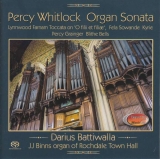Im ‘Handbuch Orgelmusik – Komponisten, Werke, Interpretation’ (Verlag Bärenreiter-Metzler, 2002) ist über die große, rund 45 Spielminuten dauernde Organ Sonata in C Minor aus dem Jahr 1936 von Percy Whitlock (1903-1946) unter anderem das Folgende zu lesen: « Die Sonata ist Whitlocks mit Abstand ehrgeizigstes Orgelwerk. Sie ist der Kriminalautorin Dorothy L. Sayers und ihrer Heldin Harriet Vane gewidmet (…). Das griechische Kryptogramm, das der Sonata vorangestellt ist (…), bedeutet: ‚On hearing the second Rachmaninow in spring‘. Damit sind mit Delius (implizit: das Kryptogramm spielt auf Delius‘ Titel ‚On hearing the first cuckoo in spring‘ an) und Rachmaninow (explizit) zwei Komponisten als ‚Paten‘ der Sonata genannt – in der Tat erinnern manche Passagen an Rachmaninows 2. Symphonie, von der sich Whitlock kurz zuvor sehr beeindruckt gezeigt hatte.“
Whitlocks Sonata umfasst vier Sätze, wobei der letzte, Choral überschrieben, mit seinen 20 Minuten den meisten Raum beansprucht. Oft wurde vermutet, dass der Komponist diesen als einen selbstständigen Fantasie-Choral geplant hatte. Das ‘Handbuch Orgelmusik’ kommt zu folgendem Urteil, dem man – das sei der Zitation vorausgeschickt – vehement widersprechen muss: « So fantasievoll der Finalsatz auch gestaltet ist, er sprengt doch durch seine Länge und die Unabhängigkeit des Materials vom Vorangegangenen den Rahmen dieser Sonata, die er nicht zum Zyklus verbinden kann.“ Richtig ist an diesem Urteil nur, dass der Satz fantasievoll ist. Alle anderen Behauptungen erweisen sich als falsch, vor allem – und damit sind wir bei dem vorliegenden Album –, wenn man die hoch transparente, fast schon kammermusikalisch-intim anmutende und dramaturgisch ebenso klug wie richtig disponierte Lesart hört, die der Organist Darius Battiwalla diesem sanften Riesen der englischen Orgelliteratur angedeihen lässt.
Die feine Akustik der Rochdale Town Hall (Greater Manchester, England) und der schlanke, dabei doch voluminöse und sehr warme Klang der SACD spielen ihm dabei buchstäblich in die Hände.
Stark auch, wie Battiwalla die Sonate, natürlich das Hauptwerk des Albums, im ‘Konzert’ der übrigen Werke platziert und inszeniert: Gleichsam als Ouvertüre erklingt die Toccata on On filii et filia von Lynnwood Farnam (1885-1930) und nach der von Battiwalla nie lang-, sondern im wahrsten Sinne des Wortes kurzweilig präsentierten Whitlock-Sonata bleibt noch genügend Luft für das kontrapunktisch dichte Kyrie des nigerianischen Komponisten, Organisten und Musikpädagogen Fela Sowande (1905-1987). Mit der auf Johann Sebastian Bach basierenden Komposition Blithe Bells von Percy Grainger (1882-1961) geht dieses hervorragende Orgel-Album auf denkbar schönste Weise zu Ende.
In the Handbuch Orgelmusik – Komponisten, Werke, Interpretation (Bärenreiter-Metzler, 2002), one can read the following about the large organ sonata in C Minor from 1936 by Percy Whitlock (1903-1946), which lasts about 45 minutes: « The sonata is by far Whitlock’s most ambitious organ work. It is dedicated to the crime writer Dorothy L. Sayers and her heroine Harriet Vane (…). The Greek cryptogram that precedes the Sonata (…) means: ‘On hearing the second Rachmaninoff in spring’. Thus, with Delius (implicitly: the cryptogram alludes to Delius’ title ‘On hearing the first cuckoo in spring’) and Rachmaninoff (explicitly), two composers are named as ‘godfathers’ of the Sonata – indeed, some passages are reminiscent of Rachmaninoff’s 2nd Symphony, by which Whitlock had shown himself very impressed shortly before. »
Whitlock’s Sonata comprises four movements, with the last, entitled Choral, taking up the most space at 20 minutes. It has often been assumed that the composer planned this as an independent fantasy chorale. The Handbuch Orgelmusik (Handbook of Organ Music) comes to the following conclusion, which must be vehemently contradicted – this should be said in advance of the citation: « As imaginatively as the final movement is designed, its length and the independence of the material from what precedes it explode the framework of this sonata, which it cannot connect to form a cycle ». The only correct thing about this judgement is that the movement is imaginative. All other assertions prove to be false, especially – and this brings us to the present album – when one hears the highly transparent, almost chamber music-intimate and dramaturgically as cleverly as correctly disposed reading that organist Darius Battiwalla gives to this gentle giant of English organ literature. The fine acoustics of Rochdale Town Hall (Greater Manchester, England) and the slender, yet voluminous and very warm sound of the SACD literally play into his hands.
The way Battiwalla places and stages the sonata, naturally the main work of the album, in the ‘concert’ of the other works is also strong: The Toccata on On filii et filia by Lynnwood Farnam (1885-1930) is heard as an overture, as it were, and after the Whitlock Sonata, which Battiwalla never presents in a long but literally entertaining manner, there is still enough room for the contrapuntally dense Kyrie by the Nigerian composer, organist and music teacher Fela Sowande (1905-1987). With the composition Blithe Bells by Percy Grainger (1882-1961), based on Johann Sebastian Bach, this outstanding organ album comes to an end in the most beautiful way.






















